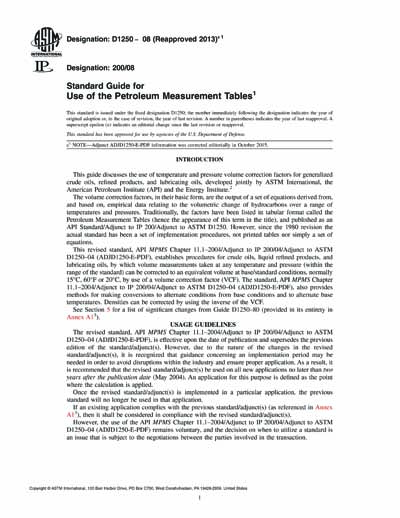
- #Astm table for crude oil manual
- #Astm table for crude oil software
- #Astm table for crude oil plus
- #Astm table for crude oil free
#Astm table for crude oil free
Rudolph Research Analytical exclusive VideoView™ ensures that your sample is bubble free for the most accurate and reproducible results. The most common source of error in measurements using digital density meters has been made easy to eliminate with the intelligent design of the DDM 2911.
#Astm table for crude oil manual
And if the manual is needed, it’s found in the DDM 2911 32GB memory! The availability of having 3 USB ports and a Cat 5 cable connection will become indispensable for communication and adding of peripherals as needed for an efficient and up to date laboratory. The DDM 2911 operates in a familiar Windows® environment making the navigation through the various menus intuitive and easy to do without the need for studying the manual. The simple operation makes it easy to train lab personnel in its use. Measurements are fast, normally requiring 2 to 3 minutes per sample. All wetted parts are corrosive resistant and not affected by the chemicals and solvents used in this industry. The DDM 2911 Density Meter is robust and requires very little maintenance. The subsequent cleaning of the sample is easy and also requires a small amount of solvent.

The sample size is small typically 1 to 2 ml is all that is required. Multiple measurements made on the same sample can also be made automatically and the statistical results calculated with the final results. For example, the API Gravity at 60 ✯, 15 ✬ and 20 ✬ along with the results at these same temperatures for density and specific gravity may all be determined in one simple and fast measurement. Numerous and simultaneous results can be calculated. Further, the printouts may be customized and used as your certificates of analysis. Results can also be printed out on any printer that is on your network.

The measurement results are displayed on the large 10.4 inch digital color screen and the results may be saved locally or saved to your server.
#Astm table for crude oil software
The DDM 2911 Density Meter provides the fastest, most accurate, and easiest means for the measurement of API Gravities. The API Gravity software that is built-into the DDM 2911 makes the use of external tables unnecessary. Using the Rudolph Research DDM 2911 Density Meter to measure API Gravity Additionally, the large sample volume required, the large quantities of solvents needed for the cleaning of the hydrometer column, and the need for a dozen or more different hydrometers to cover the entire API range has made using this method completely impractical in today’s petroleum laboratories. However, the low precision of the hydrometer as the prices of crude oils increase make this method obsolete. The historical method for the measurement of API Gravity has been the hydrometer. Each different type of petroleum product group has a different VCF. This mathematic calculation is done using Volume Correction Factors (VCF). However, for the more viscous hydrocarbons, the density is often measured at some elevated temperature and this value is then used to mathematically correct back to the proper API Gravity value for the lower temperature. The DDM 2911 Automatic Density Meter may be controlled to bring the petroleum product to any of these temperatures and make the required measurement. World it is more common to use 15 ✬ and/or 20 ✬.

In the United States, API Gravities are usually determined at 60 ✯ whereas in Europe and other parts of the The determination of API Gravity is done in an exact manner as prescribed and detailed in ASTM D-1250. The API Gravity (American Petroleum Institute) is a value which is supposed to make it easier to compare one hydrocarbon to another. Of all these measurements, density has become one of the most important and frequently used physical properties used within the petroleum industry. Therefore, the measurements of more simple properties such as flash point, vapor pressure, and viscosity have become standard chemical analysis procedures in nearly all petroleum laboratories. Characterization of these products is most complex and often impractical.
#Astm table for crude oil plus


 0 kommentar(er)
0 kommentar(er)
